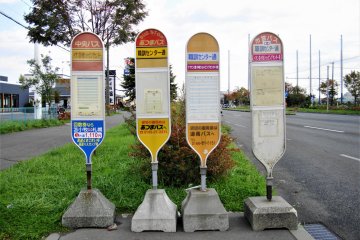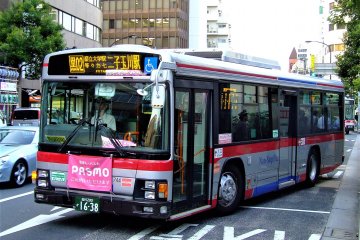Trains may steal the limelight but buses are the unheralded people movers of Japan. Whether it's the local backstreets of suburban Japan or the brand name cities and towns, don't be put off by the idea that buses are purely local knowledge. They are very simple to use. Here's how.
What you’ll need
A destination (helps to know where you want to end up) and an IC card (PASMO and Suica cards are basically interchangeable). Pick up a card from any train station service desk or machine.
Tip: top up your card before you ride. You want to be able to afford the return trip...
Finding a bus stop
For visitors, buses that originate from train station exists and shopping centres are likely to be the most practical ones. All bus stops, even back street ones, will have at least one route map and matching timetable.
Tip: give yourself enough time to look over the maps and timetables. It's no fun getting on the wrong bus.
Fares and tickets
With a topped up IC card your fare will be calculated and paid for instantly when you tap on and off. If you don’t have a card, take a small numbered ticket from the machine next to the sensor. When you get off, match your ticket number with the same number on the display board at the front of the bus. Your fare is displayed beneath that number and increases the longer you ride.
Tip: buy an IC card. Seriously.
Boarding and alighting
When boarding, tap your card or take a ticket and find a seat or stand. To alight, press the stop button (within reach of any seat) when your stop is displayed on the sign at the front of the bus. When the bus comes to a halt, make your way to the front, tap your IC card or insert your money and ticket into the little box by the driver, and off you go.
Tip: if you don’t have the exact fare, you can change up to JPY1000 in the change machine by the driver's seat.
Etiquette
Despite the non-stop automated announcements, do try and keep your own noise to a minimum as buses are considered a quiet, private space. Clean too, so no eating or drinking. Drivers take their job seriously so no chatting to them when they are driving. Also, if you're not holding on to the handrails or handrings, don’t be surprised if you get called out for it by the driver. Safety first, right?
Tip: when in doubt, copy the locals.
Riding a bus in Japan is a very simple process. Give yourself time, know your destination and, with enough credit on your IC card, you'll be touring the backstreets in no time.









